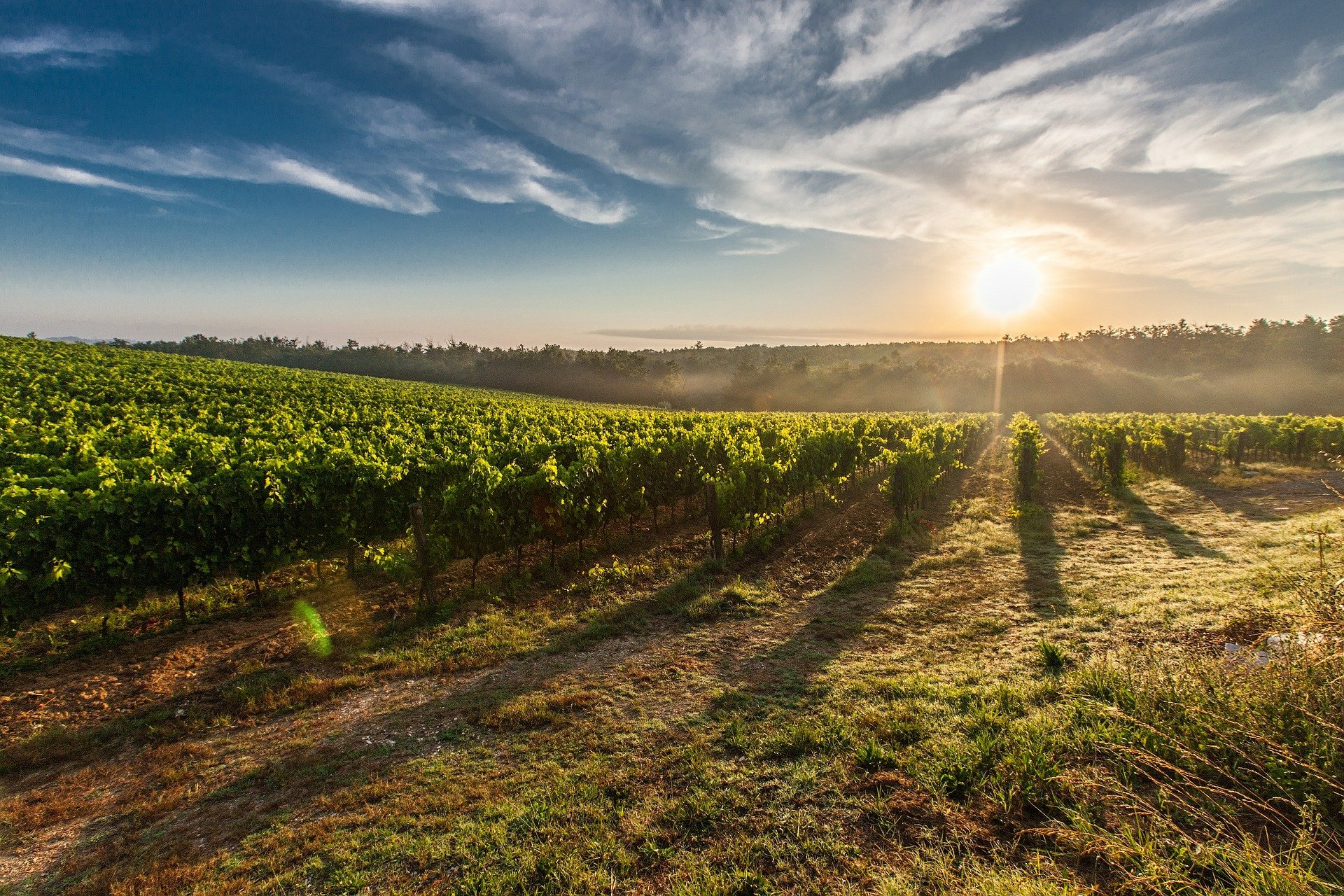
Building vineyard biodiversity to combat climate emergency
That’s pretty clear,” says leading professor and climatologist, Dr. Greg Jones about vineyard biodiversity.
Walk into a vineyard and what do you see? Vines and soil, sun and sky. This is a snapshot of place, a moment in the vineyard’s lifetime. The ecosystem here is influenced by a myriad of factors. Some work over eons — building the bedrock, for example — and some change daily. Taken together, these slow and fast factors dictate the suitability of any given Vitis to place.
The wildcard is weather and weather systems, which is to say: climate. And climate is indisputably changing. Eleven thousand international scientists, writing recently in Oxford University’s BioScience Journal, put it bluntly: “planet Earth is facing a climate emergency.” This emergency will disrupt agricultural systems worldwide, and wine, as an agricultural product, will not be exempt.
“Climate change is such a big issue, more extreme events are happening more regularly,” says Stuart Proud, viticulturalist and winemaker at Thousand Candles Winery, in Australia’s Yarra Valley. “After the recent summer of bushfires in Australia, I hope people realise how bad things could get.”
Of all the slow and fast factors that drive a vineyard ecosystem, climate feels like the hardest for a vine grower to grapple with. Soil can be amended, canopies can be managed, but the vast and chaotic shifts in weather events seem beyond human control.
Still, some viticulturists are experimenting with a mix of modern and ancient techniques to mitigate the effects of climate change. I spoke to growers in Australia, Spain, Austria, and Oregon to learn about their efforts. The short answer? It’s all about using complexity to solve a complex problem.
Climate change’s impact on vineyards
Wine is made in the vineyard. Yet nothing impacts the vineyard more than weather and climate. “In viticulture and wine production, climate is arguably the most critical aspect in ripening fruit to achieve optimum characteristics to produce a given wine style,” says Dr. Greg Jones, director of the Evenstad Center for Wine Education and professor and research climatologist in the Department of Environmental Studies at Linfield College in Oregon, writing in Guildsomm.
The vineyard cycle consists of six components: winter dormancy, early spring budbreak, mid-spring early shoot and leaf growth, summer flowering and fruit set, late summer véraison and berry ripening, and fall harvest. Each is key to a successful vintage. Yet climate changes can impact these components, disrupting this delicate system.
“During the past 15 years, we have noticed grape-ripening has changed,” says Marta Casas, winemaker of Parés Baltà in Penedès, Spain. “Due to this, we now harvest 15 days earlier than we did 20 years ago.” She highlights the 2015 to 2017 vintages as suffering from tremendous drought that created hydric stress, with transpiration rates surpassing absorption rates and resulting in feeble vines. Quantity was down 50% to 60% from previous years.
She’s not alone. Winegrowers around the globe are recording higher temperatures and reporting increased drought, amplified weather events, compressed vine cycle, and earlier harvest.
Some winemakers combat climate perturbations by adjusting grape selection. In Bordeaux, seven new grapes have been approved for experimentation, while in California’s North Coast, Larkmead Vineyards and Spottswoode Winery have developed test vineyards in preparation for warmer, more extreme climate conditions. Grapes such as Charbono, Touriga Nacional, Alicante Bouschet, and Barbera are currently undergoing suitability studies.
Vineyard biodiversity creates resiliency
Other vine growers have chosen a dirtier path, embracing biodiversity to buttress the vineyard’s ability in withstanding climate change perturbations.
“Regarding climate change, the number one framework is biodiversity within a given environment. If the biodiversity increases, then the resiliency to any kind of perturbation within the climate system is going to be stronger,” Dr. Greg Jones explains.
With almost two thousand years of history, Weingut Nikolaihof Wachau is the oldest winery in Austria and was one of the first globally to embrace biodynamic principles. Nikolaihof Wachau is experiencing increased drought and earlier harvests, but, according to Michaela Graf at Nikolaihof Wachau, through biodynamic farming practices they “do not suffer like conventional wine producers in the area.”
She shares their use of cover crops to encourage a bounty of worms, which loosen the soil allowing rain to penetrate easier while simultaneously increasing water storage capacity. They also avoid turning over the soil, a practice also known as “no-till,” so the cover crop competes against the vines for soil nutrients throughout the year. This reduces production but concentrates flavour to yield better quality wine, which, as Graf explains, is the ultimate goal.
Such avoidance in soil disturbance and cover crop practices are ideal in combating climate change, explains Jones. “Climate change evidence suggests rain events will become heavier with more annual rainfall received in few events, creating higher erosion potential,” he says. “Putting this into perspective of vineyard resilience, a great cover crop structure that isn’t tilled will not experience erosion like a tilled vineyard.”
Flame weeding in the vineyard, an organic method of weed abatement.
In the Yarra Valley, Stuart Proud also follows a no-till approach, along with other practices that together he calls “biological farming.” With 25 years of vinegrowing under his belt, he works the vineyard in the same way a chef might make a family recipe, applying the “best bits” of what he believes works from organic, biodynamic, and scientific understanding. Instead of planting cover crops, Proud allows the native microbial community to proliferate in his vineyard.
“When soils are alive with healthy fungi, bacteria, and protozoa, water infiltrates the ground better and holds moisture longer, organic matter breaks down faster, nutrients are more readily available, and vine roots penetrate deeper,” he says. “This means when tough conditions such dry spells arrive, the plants are better able to cope with the adversity because there is a bigger supply of moisture and nutrients for them to access.”
Biodynamic viticulture as one solution
While Nikolaihof Wachau has been practising biodynamics since 1971, Thousand Candles experiences equal success with vineyard biodiversity through hybrid measures. How can biodynamics, seen by some as dogmatic, offer pragmatic solutions to climate change perturbations?
“Like so many people, I started off sceptical about biodynamics. I believe in science,” explains Craig Camp, General Manager at Troon Vineyard in Applegate Valley, Oregon. “But I kept tasting wine after wine saying, ‘Wow, that is really special,’ each time reading ‘biodynamic’ on the label. I had to acknowledge there was something happening, making it my mission to learn what it is about biodynamics that created high-quality wines.”
When Craig Camp arrived at Troon he started a biodynamic conversion of the vineyard
When Camp arrived at Troon in 2016, he found the soil in poor condition from years of heavy-handed farming and feared it was ripe for fungal diseases and viral issues. Believing great wine begins with quality soil, he began a biodynamic conversion of the vineyard.
Camp avoids the dogmatic, mystical aspects of the practice. “I think what works best in wineries is practical biodynamics, studying cause-and-effect relationships.” The key, he cautions, is common sense. For example, if the lunar calendar suggests a Tuesday harvest but the forecast calls for rain, you pick on Monday. Also, Camp feels it’s critical to know one’s own property and adjust protocol to meet the specifics of your vineyard’s needs. He incorporates sound agricultural science into biodynamics’ use of compost, sprays, and teas to build up the soil’s microbial communities.
Dr. Greg Jones concurs: “I’ve long touted increasing the adaptive capacity of a given environment (vineyard/farm), improving its resiliency, makes it less vulnerable to climate change. That’s pretty clear.”
Parés Baltà experiences similar success coupling a no-till approach with biodynamic compost and teas, they have witnessed a significant increase in the mycorrhizal fungi community within the soil. Their feeble vines are now resilient.
What’s mycorrhizae got to do with it?
A powerful weapon at work below the surface of a biodiverse vineyard is mycorrhizal fungi. Their filaments tunnel through the earth, taking available soil nutrients and converting them through enzymes into food for the vines. Mycorrhizal fungi expand as they mature, connecting all their surroundings — potentially hundreds of acres — and creating a food web that balances and strengthens the entire biome. Some feel the symbiotic relationship to vine roots is an amplifier of terroir.
Supporting these fungi is one goal of biodynamics, according to Rudy Marchesi, president of Montinori Estatein Willamette Valley, Oregon, and chairman of Demeter USA. The aim “is to enhance the health and vitality of the entire farm, both above and below ground, by stimulating these fungi through building the soil’s organic component, known as humus.”
Marchesi explains that “humus acts like a sponge, protecting the vines from flooding through absorbing torrential rains, releasing the water over time as drought protection, reinforcing resilience.” As humus builds in the soil, it creates another symbiotic relationship with the environment by sequestering carbon from the air, converting it into food for the vines, further promoting mycorrhizal fungi growth.
Dr. Greg Jones anecdotally believes those who steward their vineyards by “creating a system with a diverse set of organisms, all the way down into the microbiome and into the macroinvertebrates, will be more resistant to climate impacts, so to speak.”
Tim Atkin MW agrees. Reflecting on Peter Hohlleben’s book The Hidden Life of Trees, in a recent newsletter, he shared his belief that great vineyards are like forests, communicating through roots systems, nutrients, and fungi. “I’m convinced that the healthier and more alive the terroir — and the less human intervention there is in its physical environment — the more the vineyard acts as a collective. The vines are dedicated to the aim of producing grapes with flavor and intensity, and to protecting one another from diseases and predators.”
A matter of taste
Resiliency only matters if the wine tastes good. In 1971, Nikolaihof wasn’t concerned about vineyard perturbations resulting from climate change. They had the same objective as Casas, Proud, Camp, and the others: to make the best possible wines.
“There is an energy, a liveliness in biodynamic wines you don’t see on a regular basis in other wines,” Camp explains.
“We are not just good guys trying to protect the environment, our job is to make wine,” says Marchesi. “Biodynamic viticulture produces high-quality, terroir-driven, site expressive wines. Ultimately, this is our goal.”
Source: farmingportal.co.za
